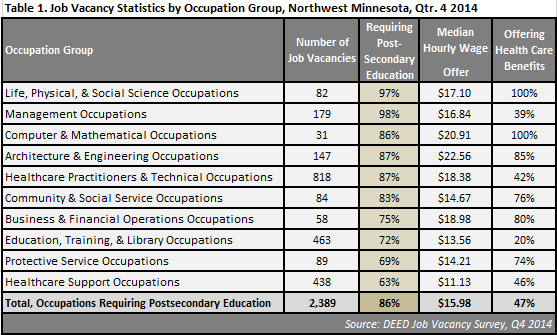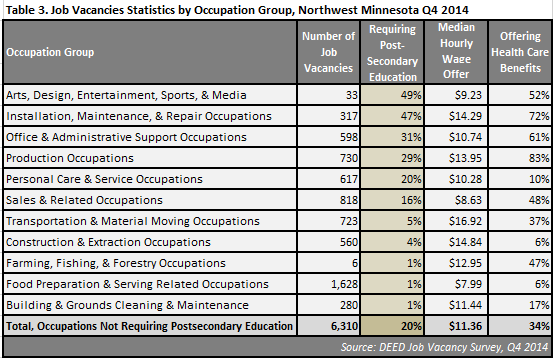 The presence of such industry powerhouses as Polaris, Arctic Cat and New Flyer make Northwest Minnesota a hub of transportation equipment manufacturing.
The presence of such industry powerhouses as Polaris, Arctic Cat and New Flyer make Northwest Minnesota a hub of transportation equipment manufacturing.
From wheat and potatoes to soybeans and sugar beets, the region is a major producer and processor of food staples and specialty agricultural products.
Want the freshest data delivered by email? Subscribe to our regional newsletters.
6/10/2015 10:30:55 AM
Chet Bodin
Despite a growing regional labor force that has increased by more than 10,000 workers in the last year, there are many open jobs in Northwest Minnesota left unfilled. In the latest results from DEED's Job Vacancy Survey, employers in Northwest Minnesota reported over 8,500 job vacancies; begging the question - why aren't employers finding workers?
For starters, let's look at the quality of job offers and whether they allow job seekers to meet their basic costs of living. While some money may be better than none, job seekers with families and other financial responsibilities are interested in sustainable careers that keep them away from job seeking permanently. As one job seeker I met recently put it, "Looking for a good job is full-time work!"
Job seekers and employers can both benefit by taking a closer look at the most recent Job Vacancy Survey (JVS) results in Northwest Minnesota. First and foremost, occupational groups that require postsecondary education typically start employees out at higher wages. Popular occupation groups that require postsecondary education in the region include healthcare and education, management, computer and mathematical, and business and finance. The average of the median wage offers was nearly $16 per hour in occupation groups where more than half the job vacancies require postsecondary education (see Table 1). According to DEED's Cost of Living tool, this exceeds what the average family with one child, one full-time worker and one part-time worker needs to make to meet its basic needs in Northwest Minnesota by over $2 an hour (see Table 2).


Less than one-third of job vacancies are in occupational groups such as food preparation, production, and sales require postsecondary education, where the average median wage offer was $11.36 per hour (see Table 3). While those wages would make it harder to afford a basic cost of living in the region, the median wage offer in four of the occupational groups - transportation, construction, production, and installation, maintenance, and repair occupations - still met the cost of living threshold.

Beyond wages, employers may also offer additional incentives. For example, only one-third of the job vacancies not likely to require postsecondary education offer health insurance, which is largely considered the most valuable job benefit. This is compared to almost half of the vacancies in occupational groups that are more likely to require postsecondary education.
So should job seekers invest in postsecondary education before looking for a job? Not necessarily - employers will often hire workers they can train themselves or subsidize education. For those who need work now but are still thinking of the future, this is an attractive incentive. Overall, whether job seekers bring an education with them or find it on the job, the additional skills education produces can lead to better wages and more opportunity for growth on the job.
Contact Chet Bodin.